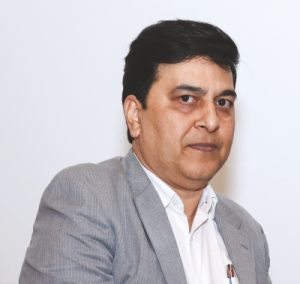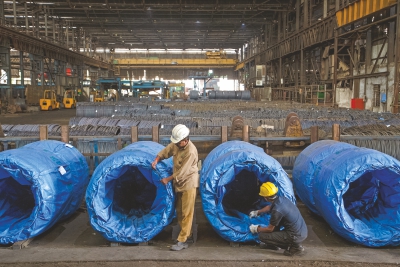Registered in 1937, Mukand Limited started operations as a ‘re-rolling mill’ and a foundry. Today, the company is one of the leading manufacturers of steel and stainless steel long products and heavy engineering equipment. Mukand has manufacturing capabilities to produce more than 400 grades. Mukand recently used silicon metal during the tapping in EOF, which resulted in minimizing the levels of aluminum and titanium in the final steel product, and improvement in the quality of the company’s steel products. In a recent conversation with Wire & Cable India, Mr. Shashibhushan Upadhyay, President, Mukand Limited, spoke on various topics like the company’s journey, recent developments, the current scenario of the global steel wire industry, the challenges faced by the Indian steel wire industry and how to overcome them.
Wire & Cable India: Could you please take us through the business journey, milestones and achievements of your company?
Shashibhushan Upadhyay: Mukand Limited, a Bajaj group company, is a leading manufacturer of specialty steel long products and heavy machinery in India. Incorporated in the year 1937, the company produces alloy steel from its facility in Hospet, Karnataka and stainless steel from its facility in Thane, Maharashtra. The company is also in the business of design, manufacture and commissioning of heavy machinery to a cross section of industries. It was in the year 1939, at the behest of Mahatma Gandhi, Shri Jamanalal Bajaj and Jeewanlal Motichand Shah took over the company from Shri Lala Mukund Lal who wanted to devote all his time to the freedom struggle. Coming to 2023, today Mukand is established as one of the leading manufacturers of steel and stainless steel long products and heavy engineering equipment. Our steel and stainless steel products are used across various industries including automobile, the industrial machinery division, designs, manufactures, assembles and commissions heavy-duty cranes, bulk material handling equipment, process plant machinery and turnkey projects. These heavy cranes are primarily used in power industry, metals production, steel industry, automobile sector etc.
Watch: RR Kabel | Solar Cables | Solar Plant | Renewable Energy
WCI: Brief us about your specialized products along with their USPs.
SU: Mukand Limited has manufacturing capabilities to produce more than 400 grades. The wires manufactured by us vary in the size range of 5mm to 30mm and can be supplied as cold finished, soft annealed and spheroidized annealed, pickled and hardened condition. Our modern and technologically upgraded wire rod mill is equipped with a walking hearth furnace and on-line measurement and automatic coil handling system. We have also deployed online automatic inspection for size and surface defects to ensure that nothing but the best is delivered to our customers.
The state of the art manufacturing facility also boasts of loop control cooling for wire rods ensuring optimal properties suiting customers’ processes.
WCI: What have been the recent developments at your organization and what are your future growth plans?
SU: Mukand Limited shall continue to focus on increasing efficiency, improving quality, and increasing its output in the year ahead. The company has invested in cutting-edge technology and modernized its production processes to ensure that its products are of the highest quality and are produced with minimal waste. In the last year, we developed several new grades in our steel business for various applications like prestressed wire, fastener Industry, seamless tube application, oil and gas industry, automotive crankshaft, railways and others.
All these new grades are specifically developed for demanding applications, in consultation with its customers. The company’s team of experts worked closely with its customers to understand their needs and requirements, and the company is proud to have developed a material that offers a unique combination of strength and corrosion resistance and can withstand extreme pressure and extreme temperature conditions. Mukand has also implemented the usage of silicon metal during tapping in EOF. This innovation has resulted in minimizing the levels of aluminum and titanium in the final steel product, particularly for spring application grades. This has led to a significant improvement in the quality of our company’s steel products, making them more suitable for various industrial applications.
WCI: Please share your views on the Indian vis a vis the global steel wire industry. What is the role of the Indian government in the growth of this sector?
SU: As a steel manufacturing company, we believe that the Indian steel wire industry holds significant potential in the global market. India has witnessed steady growth in this sector, driven by factors such as increasing infrastructure development, construction activity, transportation and mobility and industrialization. India has witnessed substantial growth in its steel wire production capacity in recent years. With the establishment of new manufacturing facilities and technological advancements, India has the ability to produce a wide range of steel wire products to meet domestic as well as international demand.
The global steel wire industry, on the other hand, has a diverse production capacity spread across various countries, with established players in developed and emerging economies. One of the significant trends influencing the global steel wire industry is the increasing demand for superior-quality and high-performance steel wire products. This demand is driven by the growing need for lightweight materials across various sectors, including automotive and aerospace. Manufacturers are actively responding to this trend by investing in innovative approaches to produce steel wire products that offer exceptional strength, resilience, and corrosion resistance. These advancements enable them to meet the rising demand for cutting-edge solutions that align with the evolving requirements of industries seeking lightweight yet durable materials.
The Indian government plays a crucial role in fostering the growth of the steel wire industry. Various initiatives and policies implemented by the government of India like the National Steel Policy, which seeks to boost the nation’s steel production capacity to 300 million metric tons by 2030 and enhance the competitiveness of the industry. The government has also taken steps to promote ease of doing business, attract foreign investment, and encourage research and development in the steel sector.
Also Read: Miki Wire Works Introduces “Green Route” for High Carbon Wire, Now an Industry Practice
Additionally, the government has undertaken infrastructure projects that boost demand for steel wire, such as the development of smart cities, metro rail systems, and rural electrification. These initiatives create a favorable environment for the growth of the steel wire industry and provide opportunities for domestic manufacturers to meet the increasing demand. In addition to this, the government’s emphasis on Make in India and self-reliance has further bolstered the steel wire industry by promoting domestic manufacturing. This has led to a more robust and competitive domestic steel wire market.
In a nutshell, the steel wire industry is projected to grow, owing to its increased demand from various industries from across the globe. There has been a significant rise in global buyers expressing interest in establishing enduring partnerships with Indian companies, which is an extremely positive development. However, it becomes imperative for the Indian steel wire industry to shift its focus towards a more quality-centric approach in order to bring India to the forefront of the industry.
“ This demand is driven by the growing need for lightweight materials across various sectors, including automotive and aerospace. Manufacturers are actively responding to this trend by investing in innovative approaches to produce steel wire products that offer exceptional strength, resilience, and corrosion resistance. ”
WCI: What are the major ongoing challenges in the Indian steel wire industry?
SU: With the growth of the economy and the increased focus on manufacturing, India is soon going to be the manufacturing hub of the world and the wire industry can not stay far behind when this growth happens. As a country, we might not be able to utilize the full capacity of wire manufacturing so we will have to find ways to improve our export share in this market. However, the road to this may not be as easy as it sounds. The industry will have to prepare to provide the best quality products at competitive prices. The price of the steel wires largely gets influenced by the cost of the raw material which are mainly imported. Hence, in order to effectively compete with manufacturing hubs like China and other global players, the Indian steel wire industry may need to procure raw materials at a competitive price.
Also, it becomes crucial for the steel industry to focus on optimizing costs throughout the value chain, including raw material procurement, production processes, and supply chain management. This may involve exploring alternative sourcing options, negotiating favorable pricing contracts, improving operational efficiencies, and adopting cost-effective technologies. Lastly, it becomes important for the government to create a conducive business environment. This can include measures such as reducing import duties on raw materials, streamlining regulatory processes, and providing incentives to promote cost competitiveness.
WCI: How can these challenges of the industry be addressed?
SU: Addressing these challenges requires collaborative efforts from industry stakeholders, government support, and a proactive approach to innovation, infrastructure development, skill enhancement, and market adaptation. By addressing the pricing challenges and improving cost efficiencies, the Indian steel wire industry can enhance its competitiveness on the global stage and effectively compete with manufacturing hubs while meeting the demands of international buyers. By continuously optimizing processes, by adopting advanced manufacturing technologies, and promoting innovation we can establish a competitive edge in the market.






